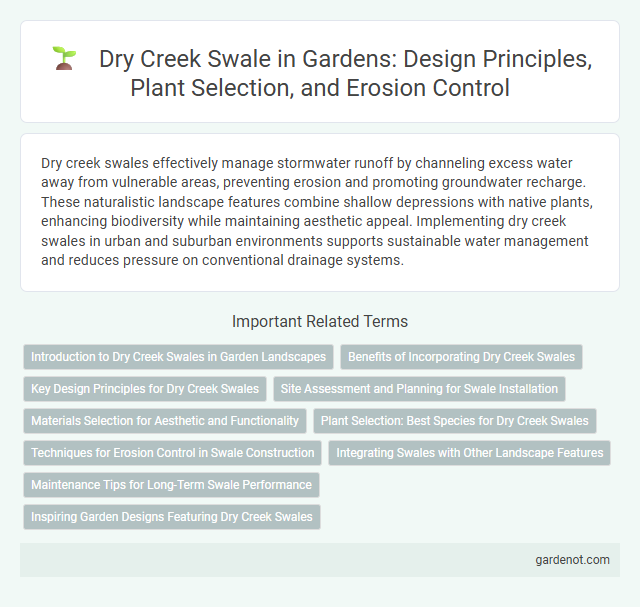Dry creek swales effectively manage stormwater runoff by channeling excess water away from vulnerable areas, preventing erosion and promoting groundwater recharge. These naturalistic landscape features combine shallow depressions with native plants, enhancing biodiversity while maintaining aesthetic appeal. Implementing dry creek swales in urban and suburban environments supports sustainable water management and reduces pressure on conventional drainage systems.
Introduction to Dry Creek Swales in Garden Landscapes
Dry Creek Swales enhance garden landscapes by efficiently managing stormwater through shallow, vegetated channels that mimic natural waterways. These swales reduce erosion, improve water infiltration, and support native plants, contributing to sustainable and low-maintenance garden ecosystems. Incorporating Dry Creek Swales into landscape design promotes groundwater recharge while adding aesthetic value with naturalistic stone and plant arrangements.
Benefits of Incorporating Dry Creek Swales
Dry creek swales enhance stormwater management by promoting natural infiltration and reducing surface runoff, which mitigates flooding and erosion. These systems support groundwater recharge and improve water quality by filtering pollutants through vegetation and soil media. Incorporating dry creek swales also creates aesthetically pleasing landscape features that boost urban biodiversity and provide habitat connectivity.
Key Design Principles for Dry Creek Swales
Dry creek swales are designed to mimic natural stream channels, incorporating gradual slopes and vegetated channels to enhance infiltration and reduce runoff velocity. Key design principles emphasize proper sizing to accommodate peak stormwater flows, use of native vegetation to stabilize banks and improve water quality through filtration. Incorporating soil amendments and underdrains can further optimize drainage and support pollutant removal in dry creek swale systems.
Site Assessment and Planning for Swale Installation
Dry creek swale site assessment requires detailed analysis of soil permeability, slope gradient, and existing drainage patterns to ensure effective water infiltration and runoff control. Planning involves selecting appropriate swale dimensions, vegetation types, and outlet structures to maximize stormwater management and prevent erosion. Incorporating local climate data and land use considerations enhances the swale's long-term functionality and sustainability.
Materials Selection for Aesthetic and Functionality
Dry creek swales utilize a combination of gravel, river rocks, and native soil to enhance both aesthetics and water filtration capacity. Selecting materials with varied textures and colors mimics natural creek beds, promoting visual appeal while ensuring effective stormwater infiltration. Incorporating drought-tolerant plants alongside permeable substrates reduces erosion and supports sustainable water management.
Plant Selection: Best Species for Dry Creek Swales
Optimal plant selection for dry creek swales includes drought-tolerant species such as native grasses, sedges, and deep-rooted perennials that stabilize soil and enhance water infiltration. Species like Blue Grama (Bouteloua gracilis), Switchgrass (Panicum virgatum), and Purple Coneflower (Echinacea purpurea) thrive in well-drained conditions and provide habitat benefits. Incorporating flood-tolerant shrubs such as Red Twig Dogwood (Cornus sericea) improves erosion control while supporting ecological diversity in dry creek swales.
Techniques for Erosion Control in Swale Construction
Effective erosion control in dry creek swale construction employs techniques such as vegetation stabilization, including native grasses and groundcovers that reduce soil displacement. Structural measures like check dams, rock linings, and biodegradable erosion control blankets help slow water flow and protect swale banks from washout. Integrating proper grading and drainage design minimizes runoff velocity, ensuring long-term swale durability and soil retention.
Integrating Swales with Other Landscape Features
Dry creek swales enhance stormwater management by seamlessly integrating with rain gardens and permeable pavements to maximize infiltration and reduce runoff. Aligning these swales with natural contours and existing vegetation supports biodiversity while stabilizing soil and preventing erosion. Incorporating native plantings within dry creek swales further improves water quality by filtering pollutants and providing habitat for local wildlife.
Maintenance Tips for Long-Term Swale Performance
Regular removal of sediment and debris from a dry creek swale ensures unobstructed water flow and prevents erosion. Periodic inspection of vegetation helps maintain plant health, which stabilizes soil and enhances infiltration rates. Implementing these maintenance practices supports long-term swale performance by preserving its water management and filtration functions.
Inspiring Garden Designs Featuring Dry Creek Swales
Dry creek swales provide effective drainage solutions that enhance garden aesthetics by mimicking natural water channels, preventing soil erosion while adding visual interest. Incorporating native plants and decorative rocks within dry creek swales promotes sustainable landscaping, supporting local ecosystems and reducing water runoff. This design technique creates a dynamic focal point, blending functionality with eco-friendly beauty in modern garden layouts.
Dry creek swale Infographic

 gardenot.com
gardenot.com